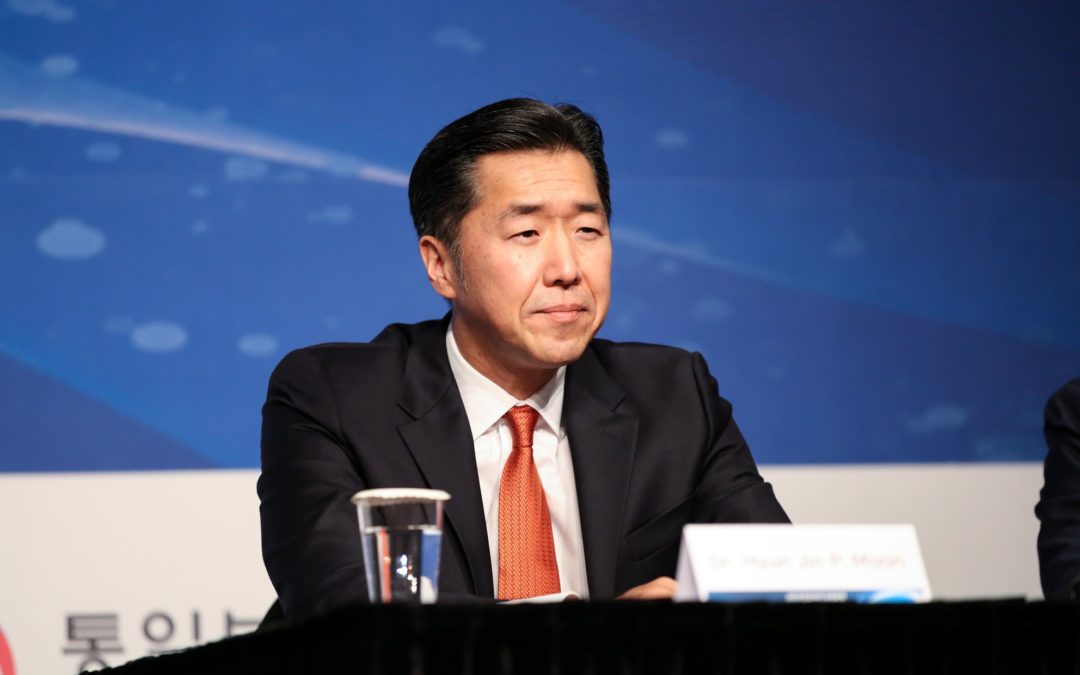August 14, 2019
Plaza Hotel – Seoul, South Korea
Dr. Hyun Jin Preston Moon, founder and chairman of the Global Peace Foundation, addresses international experts, leaders and activists for Korean reunification at the International Forum for One Korea 2019 in Seoul, Korea.
International Forum on One Korea, Seoul Korea
Ladies and gentlemen, welcome back to Seoul, Korea, for the second convening of the One Korea Forum this year. It was just a few months ago in March that we conducted the first of these forums to recognize the centennial of the Sam-il movement for Korean independence and to tie that legacy to our current efforts for the peaceful unification of the peninsula. Many of you contributed to the resounding success of that convening and since then many new participants and partners swelled the ranks of Action for Korea United (AKU).
l would like to recognize the many Korean dignitaries and patriots gathered here today from the Republic of Korea and the diaspora communities from around the world as well as our co-convener the East-West Institute and its President, Dr. William Parker. I also wish to recognize Dr. Henry Hwang, President of the Center for China and Globalization, and a Counselor of the China State Council.
The Context of US relations with the DPRK
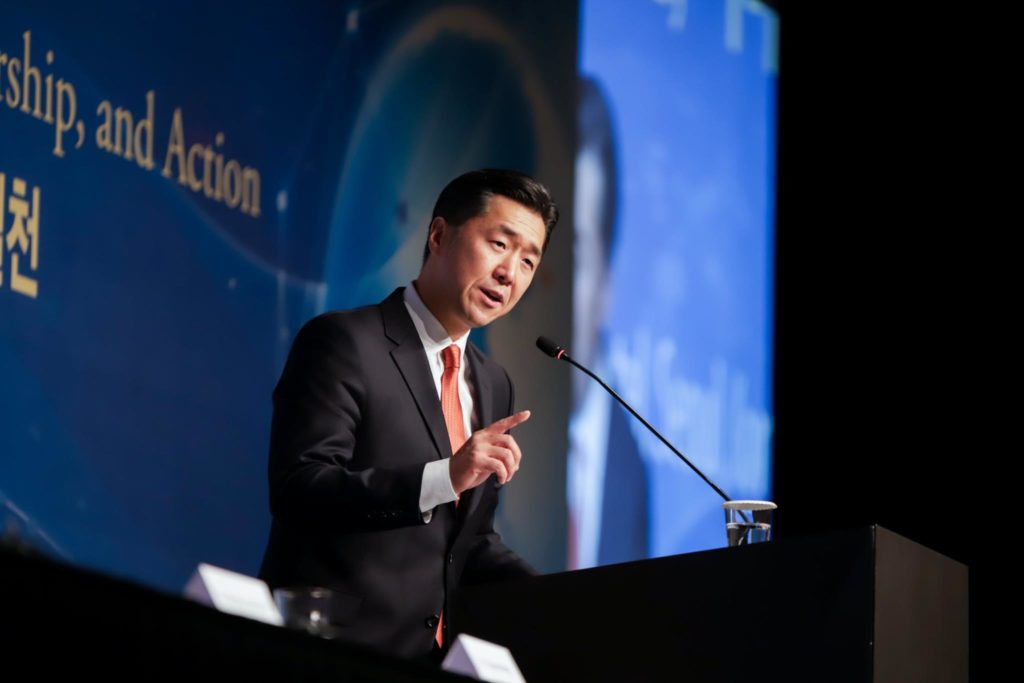
Dr. Moon urges Koreans, North, South and the diaspora to seize this historic opportunity to fulfill their long-held aspirations for a “free, united and independent” Korea.
Ladies and gentlemen, I believe we are at an inflection point in the history of the Korean people, the peninsula, Northeast Asia and the world.
The developments over the last two years on the peninsula have been both tumultuous and dramatic. In 2017, an international crisis was precipitated by North Korea’s nuclear and ballistic missile tests accompanied by its bellicose threats to its neighbors and, especially, the U.S. It triggered a comprehensive international sanctions regime that drew unprecedented support from the North’s traditional allies, Russia and China, with a very real and credible threat of military action by the United States.
These developments prompted a rapid about-face from Kim Jong Un and his regime, who had been accustomed to the policy of diplomatic appeasement by the South and its Western allies whenever the North threatened the region. Surprised by the unprecedented level of global condemnation and isolation with the very real possibility of war, the North launched a full-scale “peace” initiative and found a willing partner in President Moon Jae-in of South Korea.
Kim sent a delegation to the Pyeong Chang Winter Olympics in 2018 and followed up with a series of inter-Korean summits. There was broad talk at these meetings of a mutual commitment to reunifying the peninsula without any outside interference. But though they were rich in symbolic photo opportunities, there were few practical details and no real accomplishments to that end. Nevertheless, at President Moon’s urging, those meetings opened the door to two unprecedented summits between President Trump and Chairman Kim in Singapore and Hanoi.
The Singapore Summit on June 12, 2018 between the United States and the Democratic Peoples Republic of Korea led to broad, unspecified agreements to denuclearize the peninsula for full sanctions relief and US commitment to maintain the survival of the Kim regime. As a token gesture of good faith, the North even publicized the destruction of one of their obsolete nuclear facilities, returned the remains of US servicemen from the Korean War, released several Americans held in captivity and ceased their ballistic missile tests. All these developments were hailed as a historic milestone in US relations with North Korea.
Understandably, the expectations were high for the Hanoi Summit that took place on February 27th of this year, just a few days before the centennial celebrations of the Sam-il movement and the One Korea forum, since the parties had a full eight and a half months to come to an agreement. Yet, in this environment where policy experts and media pundits in both the US and the South were anticipating the possibility of a “big deal” or “small deal,” I predicted that the summit would lead to “no deal.” In line with that prediction, on the following day, February 28th, the White House announced that the summit would be cut short since the North was demanding complete sanctions relief without taking the necessary steps to denuclearize.
Post-Summit Geopolitical Reality
The Hanoi summit exposed the fallacy in American assumptions that direct bilateral talks with the DPRK could lead to CVID (complete, verifiable, irreversible denuclearization). The US failed to recognize that the North’s nuclear program is not just an insurance policy to regime survival but more importantly tied to its “raison’d’etre” as a self-reliant, accomplished state. Unlike the “miracle on the Han” in the South, the North has no accomplishment other than its nuclear program that it developed at enormous cost in national resources and strained diplomatic relations with the larger global community.
It is important to understand that, for the regime, their nuclear program is a source of national pride directly tied to the Kim legacy. To give it up would be to forgo that identity and, ultimately, its legitimacy in the eyes of the North Korean people. As a result, it would never willingly give up its nukes, especially under pressure from a foreign power such as the United States.
These summits also highlighted the misguided extent to which the US was willing to go to broker a deal with the North. If the United States were to guarantee the survival of the Kim regime in exchange for denuclearization, it would be supporting the most ruthless despotic dictatorship in the world today, undermining its moral authority as the champion of democratic self-government as well as fundamental human rights and freedoms. The US legacy of promoting these timeless universally accepted American ideals with blood and treasure since the end of the Second World War to the conflicts in the Gulf would be undermined.
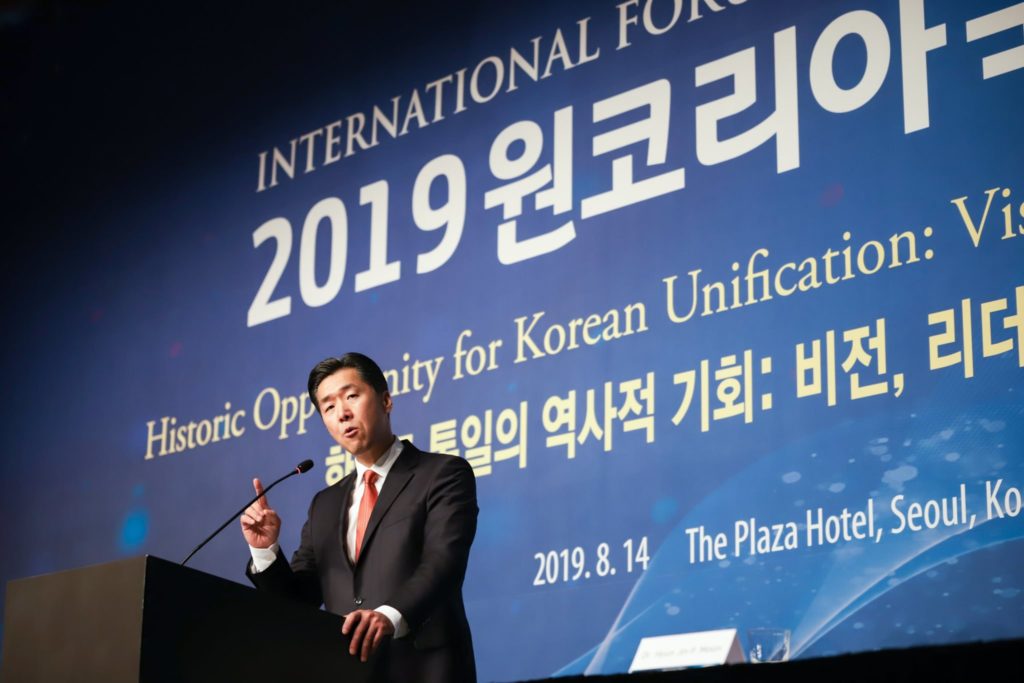
Dr. Hyun Jin Moon urges for regional cooperation for the peace and prosperity of Northeast Asia.
In addition, the US failed to recognize the geopolitical consequences of bilateral talks with North Korea. This broke with longstanding US policy to work through its Southern ally to ensure the tripartite alliance of the ROK, US and Japan as well as recognize South Korean leadership on peninsular matters concerning the two Koreas. Direct American talks with the North would reconfigure this paradigm, prompting its geopolitical rivals, such as China and Russia, to mend its strained relationship with the DPRK and check US involvement on the peninsula. As a result, it would undermine the global sanctions regime that brought the North to heel and provide a justification to meddle in Korean affairs.
The announcement of the Singapore Summit led to a series of meetings between Xi Jinping and Kim Jong-un. The first taking place last year in Beijing in March and the second in Dalian in May. After the historic summit between Trump and Kim, another meeting was held in June. This was then followed by two meetings this year in January, a month before the Hanoi Summit, and another recently in June. Shortly after these meetings, there was clear evidence to suggest that China violated its sanctions obligations.
In addition, Russian Foreign Minister Sergei Lavrov visited North Korea shortly after Singapore. It was recently followed by an official summit between Russia and the DPRK on April 25th of this year, upon the invitation of President Vladimir Putin. According to reports, Putin concluded that international security guarantees were needed for the North to give up its nuclear arsenals since US guarantees were not enough to convince Kim, harkening Russian involvement.
Putin’s conclusions foreshadowed what was to come. Russia had strengthened its military alliance with China after souring its relationship with NATO over Ukraine and Crimea. The failed talks between the US and the DPRK in Hanoi gave Putin and Xi the necessary justification to project their collective military might over the peninsula in order to guarantee the security of the Kim regime. On July 23, they conducted their first joint military air patrol in the Asia Pacific, violating South Korean and Japanese air space, igniting an incident where the ROK fired 300 warning shots at a Russian aircraft.
Strangely, as the Russians and Chinese projected their military might over Korean airspace and the North restarted its missile tests in clear violation of the agreement outlined in Singapore, the United States paired down its commitment to the South’s defense by minimizing its participation in the US-ROK joint military exercises. The reason President Trump gave for America’s position was that he received a “beautiful letter” from Kim Jong-un who beseeched him not to participate and because he did not want the US to pay for them. Ironically, the purpose of the tripartite alliance between South Korea, Japan and the United States is to contain Northern aggression as well as check Russian and Chinese influence on the peninsula.
With the lack of American leadership, it is not surprising, then, that the fragile tripartite alliance would start to fray. In early August, Japan announced that it would tighten control over three essential chemicals that are crucial in the development of semiconductors in Korea, launching a trade war that could severely cripple the Korean and Japanese economies. The reason cited for these restrictions was Japan’s suspicion that South Korea, under the liberal Moon regime, was “leaking sensitive information to North Korea.” With heightened tensions in both countries, Japanese leadership doubled downed by removing the ROK from its “white list” of trusted trade partners with the South threatening to retaliate in kind.
Although South Korea sought help from the United States, it failed to recognize that Prime Minister Shinzo Abe was using the same playbook President Trump created in renegotiating bilateral trade with China. As a result, although the US could make open overtures to mediate, it would not get involved. This has led the South to air old historic grievances such as Japan’s use of Korean forced laborers during World War II as the reason for these measures, reopening old wounds in the relations of both countries. According to some analysts, there is truth to those accusations because as they see it, Japan’s tarnished war record gets in the way of Abe’s ambition “to make Japan great again.”
The Challenges of the new geopolitical Reality
Ladies and gentlemen, clearly, the world is not a safer place today, especially in Northeast Asia. Whatever opportunities were created on the peninsula in the latter months of 2017 and the beginning of 2018 due to strong American leadership had been squandered by an opportunistic personal diplomacy without the discipline of a larger strategic framework with clearly defined realistic outcomes. As a result, the current reality reflects this confusion and lack of clarity.
From the perspective of the United States, where does it go from here? Will it continue to pursue its policy of CVID, although the DPRK would never give up its nukes through bilateral talks? The Trump administration would have us believe that the president’s personal diplomacy with Kim would lead to some kind of deal. What kind of deal will that be? What will the US be willing to give up and what would the consequences of that agreement be on the Republic of Korea and the Korean people?
How would American direct involvement affect the actions of its geopolitical rivals such as China and Russia? Clearly, US bilateral talks with the DPRK triggered their involvement in Korean affairs, what will their actions be in the days to come? The military intrusion over Korean and Japanese airspace by Russia and China heightens the possibility of confrontation that did not exist since the collapse of the Soviet Union. Does this bode a new Cold War in the Northeast Asian region?
How would the United States maintain its fragile tripartite alliance with South Korea and Japan when its two greatest allies in the region are now engaged in a trade war, largely inspired by the US? The trade war would weaken both the ROK and Japan economically and stoke historic grievances, naturally weakening regional security and stability. This reality becomes amplified with renewed Russian and Chinese interests on the peninsula. How will the US deal with these challenges?
It is important to note that it was the President of South Korea, Moon Jae-in, who initiated the bilateral talks between the United States and the Democratic People’s Republic of Korea. Not only was this unprecedented it would mean that the ROK forgo its role in the denuclearization talks between the US and the North although it would be the most affected by the outcome. So, why did he abdicate South Korean leadership on peninsular matters to the United States?
Moon tacitly agreed to the goal of unification with Kim during the inter-Korean summits, what kind of unification did they agree on? With US acknowledgment of the DPRK, would it not strengthen the North’s position as an equal partner to the South, although the latter has twice the population and over 40 times the size of the North Korean economy? Wouldn’t this new-found status of the North hurt South Korean leadership? Then, how is that beneficial to the South?
Most importantly, would it not ensure a two-state reality on the peninsula, where both states have the backing of the United States? Then, what would be the incentive to unify? How would unification come about? Would it not make the process of unification more difficult?
Equally important, what will happen to Korea-Japan relations given the current trade war? Will Japan be increasingly isolated in the region and feel the need to rearm for its national defense, further enflaming historic grievances among its neighbors? How will that further affect the geopolitics of the region? The questions go on and on.
The Korean Dream Paradigm
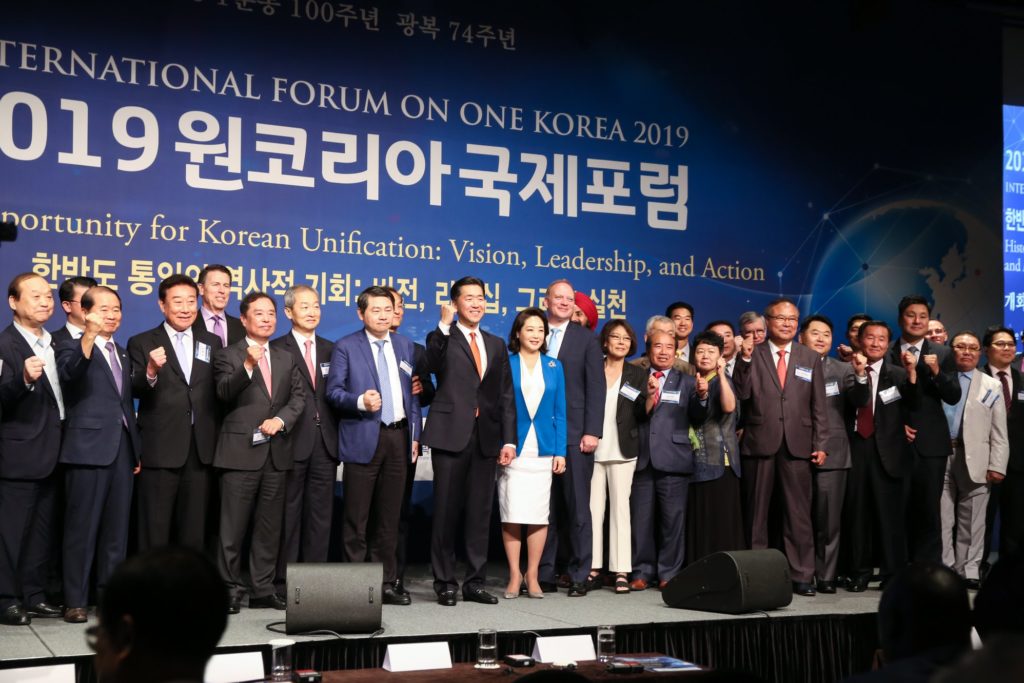 It is exactly in times of uncertainty that a clear vision is needed to provide a solution to the many vexing problems of that age; and, as I have listed, there are no shortages of problems that face the peninsula, the region and the world. Yet, I have provided such a vision in my award-winning book the Korean Dream: Vision for a unified Korea as well as many public speeches, published op-ed pieces and interviews. The fundamental thesis of the Korean Dream paradigm is that unification should be looked as an opportunity to create an ideal nation in line with the founding philosophy of Hong-ik Ingan that charged the Korean people to “live for the betterment of all mankind.”
It is exactly in times of uncertainty that a clear vision is needed to provide a solution to the many vexing problems of that age; and, as I have listed, there are no shortages of problems that face the peninsula, the region and the world. Yet, I have provided such a vision in my award-winning book the Korean Dream: Vision for a unified Korea as well as many public speeches, published op-ed pieces and interviews. The fundamental thesis of the Korean Dream paradigm is that unification should be looked as an opportunity to create an ideal nation in line with the founding philosophy of Hong-ik Ingan that charged the Korean people to “live for the betterment of all mankind.”
By doing so, this vision challenges the existing Cold War paradigm of North and South on the peninsula as well as the hyper-partisan ideological divide of Left and Right in domestic South Korean politics as foreign constructs imposed upon the Korean people after liberation. It reminds all Koreans of our common heritage and shared historic cultural legacy that spanned five millennia and allowed us, as a people, to overcome untold difficulties throughout our turbulent past. In short, seventy plus years of division cannot define five thousand years of our common heritage. Thus, the inevitable destiny of the Korean people is to create a new model nation out of the ashes of division and conflict that could “benefit all mankind.”
In addition, the high-minded ideals of Hong-ik Ingan led us to seek spiritual truths with an open-minded attitude towards all the major faith traditions of the world, leading to enlightened notions of human rights and freedom outside the experience of the West. Thus, a unified Korea would be a natural bridge between East and West as well as the old and new. Interestingly, although it is an ancient civilization and a foundational pillar of East Asia, its aspirational ideals resonate with the modern values of all the Western democracies. More importantly, throughout its history, Korea was never an aggressor nation but sought to maintain cordial relations with all its neighbors, naturally positioning it to be an advocate for peace and stability within the region.
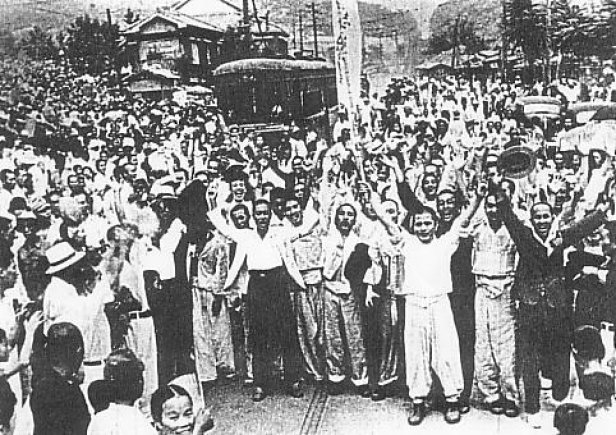
August 15, Koreans had an opportunity to create a nation founded on the noble ethics of their heritage. But it was lost as two Koreans formed.
In 1948, national elections were to be held to form a unifying government but it never came to pass due to the formation of the two Koreas. The fact that both the North and South have ROK in their official names shows that they both were trying to lay claim to their roots in the Korean independence movement where the idea of creating a Western-style republic was formed. Inspired by Hong-ik Ingan, the founders of the independence movement had no intention to reinstate the Chosun dynasty but instead sought to create a new nation that could better realize those ideals. It is with that same heart that our generation should realize that dream.
The creation of a new nation aligned to the Hong-ik Ingan ideal would naturally resolve the nuclear threat of North Korea since Korea will be at peace with all its neighbors. In addition, the synergies from unification between the economically advanced yet resource-poor South and the economically poor but resource-rich North would create an economic boom that would stimulate the regional and global economies. Unlike those who see unification in terms of costs, citing the German example, I believe a better way to view unification is in terms of a merger where natural synergies will drive value creation, especially if it is guided by sound economic policy. As a result, it is my belief that a unified Korea would eventually be among the top five economies in the world.
Thus, harkening back to the newly formed United Nations charge that Korea should be “united, independent and free,” the international community led by the United
States should champion the peaceful unification of the Korean peninsula, followed by China and Russia. This process should be Korean led, without the interference of great powers like the post-war environment of World War II. What I mean by Korean-led is not just the two Korean governments but the Korean people in general that make up the North, South and the diaspora. That is why wide-ranging, diverse civic collectives like Action for Korea United is so important since it represents the breadth of society aligned to a common vision for unification—the Korean Dream.
Lessons from 1919
The leaders of the Korean Independence Movement understood the importance of vision, principles and values. That is evident in the Korean Declaration of Independence, a document produced by diverse leaders of different religious and civic groups, including my own great grand uncle, Moon Yun-gook. A remarkable document in and of itself, the Declaration becomes more significant given the context in which it was written: a time of deep suffering and struggle for the Korean people under Japanese colonial oppression.
Given those circumstances, it is remarkable that the Declaration calls for both Koreans and Japanese alike to “correct past mistakes and open a new phase of friendship based upon genuine understanding and sympathy.” Calling upon Koreans to move beyond hatred and resentment, it urged dignity and restraint towards their would-be enemies and simultaneously offered a hopeful vision to transform Japan-Korea relations from that of colonizer and colonized to mutual partners in promoting peace in Asia.
The Declaration became the unifying force and catalyst for a civil society outpouring, engaging Koreans of all different backgrounds and walks of life across the entire peninsula. It was, of course, informed by the American Declaration and the universal aspirations of all people. But we should take pride in the fact that it was first and foremost grounded in Hong-ik Ingan. Today, it can serve as a guide and inspiration for a people’s movement toward a unified Korea of high ideals.
I cannot emphasize enough the importance of a forward-looking approach that inspires people toward a new and better future. While we must resolve issues and learn from the past, what is most important is to embrace a shared vision that gives clarity and substance to our ideals and aspirations. Too often, political leaders stoke resentments from the past for their own short-term advantage, rather than striving toward long-term solutions.
The current disputes between Japan and ROK, inflamed by historic grievances, are a serious problem. It is essential that leaders strive to transcend those grievances and narrow political interests to preserve the vital alliance between Korea, Japan and the United States as the cornerstone for security in the pan-Pacific region and the foundation for peaceful unification. Otherwise, the Peninsula and Northeast Asia may well again become the most dangerous hot spot in the world, as recent events in the region are already indicating.
Conclusion
One hundred years ago our ancestors gathered peacefully in towns and cities across this land, in both the North and the South, in the historic Sam-il movement. Two million of them over three months met to read aloud the Korean Declaration of Independence and call for an end to Japanese colonial rule. They declared their support for a Korean nation that was “united, independent, and free.”
They drew inspiration from the peace negotiations then being held in Versailles at the end of the First World War. They were encouraged by the vision, both principled and practical, expressed in U.S. President Wilson’s Fourteen Points, especially the point calling for the independent, self-determination of colonized nations.
Tomorrow, August 15th, is the anniversary of Korean liberation from Japanese colonial rule with the end of the Second World War in the Pacific. This day represents a moment in time when the aspirations of the Independence movement could have been fulfilled. Yet, by 1948, with the creation of two separate governments, the dream to create a unified, independent nation true to the ideals of Hong-ik Ingan were dashed.
Today, nearly three-quarters of a century later, we are still living with the consequences of that failure. The Korean people are divided under two diametrically opposed ideological, political and economic systems, with rival governments in a continual state of war. We, as Koreans, need to recognize the futility of this reality and seek to create a new one.
Although these are precarious times, I believe we are at an inflection point of great transformation if only we can dare to dream big. Inspired by the spirit of the March 1st movement, Action for Korea United is becoming the new independence movement of our time. I call upon all Koreans to summon the same determination as our forefathers, unfettered by past tragedies and undaunted by current realities, to embrace this noble cause. It is our calling and our destiny as Korean patriots, to be the change agents that can spark a new tomorrow by realizing the Korean Dream of a unified Korea that will “benefit all humanity” in the spirit of Hong-ik Ingan.
Ladies and gentlemen, a united Korea of high ideals will end the ominous threats to peace and security in East Asia and will greatly benefit the world. I urge all of you, your families and communities to be a part of this great work to realize the Korean Dream.
May God bless you and your family. Thank you very much.

